2021 Thesis Cohort
On this page:
Kūpono Aguirre
Kūpono is from Waikapū, Maui, Hawaiʻi. His thesis is on seed dispersal of feral pigs in Hawaiian forests, focusing on the moku of Hilo. Animals are responsible for dispersing seeds from up to 90% of tree species in tropical rainforests. For his research he will be collecting pig scat from various forests around Hilo and germinating it in a greenhouse. He will check on the samples weekly to identify the germinants and remove them from the media. His favorite part of his thesis experience is being able to do original research and explore questions that he is passionate about. The most challenging part has been applying for permits and getting through all the red tape of government agencies.
Walter Boger
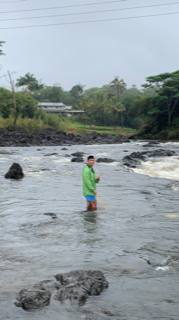 Walter is from Maryland. His thesis is on shifts in Carbon Exports from a Hawaiian Watershed under a Changing Climate, focusing on the Wailuku River. The Wailuku River translates to waters of destruction. Walter says, “In storm flow conditions the river deserves that name”. This project is examining the impacts of climate change on carbon exports from the Wailuku River, Hawaii island, USA, to Hilo Bay. Climate change is expected to shift rainfall patterns, affecting river discharge and the amount and timing when carbon, in all its forms, is delivered to Hilo Bay. A better understanding of how the export of carbon will change under future climate conditions is essential for managing this coastal food web that many people depend on for their livelihood, sustenance, recreation, and cultural practice. His favorite part of the experience is working in the river. The most challenging thing for him has been writing. He has written for his proposal, funding agency, and conferences. The practice has been important.
Walter is from Maryland. His thesis is on shifts in Carbon Exports from a Hawaiian Watershed under a Changing Climate, focusing on the Wailuku River. The Wailuku River translates to waters of destruction. Walter says, “In storm flow conditions the river deserves that name”. This project is examining the impacts of climate change on carbon exports from the Wailuku River, Hawaii island, USA, to Hilo Bay. Climate change is expected to shift rainfall patterns, affecting river discharge and the amount and timing when carbon, in all its forms, is delivered to Hilo Bay. A better understanding of how the export of carbon will change under future climate conditions is essential for managing this coastal food web that many people depend on for their livelihood, sustenance, recreation, and cultural practice. His favorite part of the experience is working in the river. The most challenging thing for him has been writing. He has written for his proposal, funding agency, and conferences. The practice has been important.
Nathalie de Rocquigny
 Nathalie is from Winnipeg, Canada. Her thesis is on behavior, infestation, and molecular characterization of Cryptophlebia spp associated with Macadamia Nut in Hawai’i. Her research is primarily being conducted in Kea’au and Kapa’au Hawai’i. When asked for a fun fact about her research, she said, “The same man who introduced Macadamia Nut into Hawai’i also was the one to bring in mongoose”. She is also a teacher’s assistant for the College of Agriculture; she assists students in their Ag labs and contributes to their knowledge on farming systems. Her research takes place in large-scale Macadamia Nut farms where she studies two species of moths that significantly reduce yield. Her career goal is to help find ways to reduce yield loss from insects and other pests to help producers in the fight against invasive species. Her favorite part of her thesis experience is playing with the caterpillars she finds. The most challenging part of her thesis is writing.
Nathalie is from Winnipeg, Canada. Her thesis is on behavior, infestation, and molecular characterization of Cryptophlebia spp associated with Macadamia Nut in Hawai’i. Her research is primarily being conducted in Kea’au and Kapa’au Hawai’i. When asked for a fun fact about her research, she said, “The same man who introduced Macadamia Nut into Hawai’i also was the one to bring in mongoose”. She is also a teacher’s assistant for the College of Agriculture; she assists students in their Ag labs and contributes to their knowledge on farming systems. Her research takes place in large-scale Macadamia Nut farms where she studies two species of moths that significantly reduce yield. Her career goal is to help find ways to reduce yield loss from insects and other pests to help producers in the fight against invasive species. Her favorite part of her thesis experience is playing with the caterpillars she finds. The most challenging part of her thesis is writing.
Amy Durham
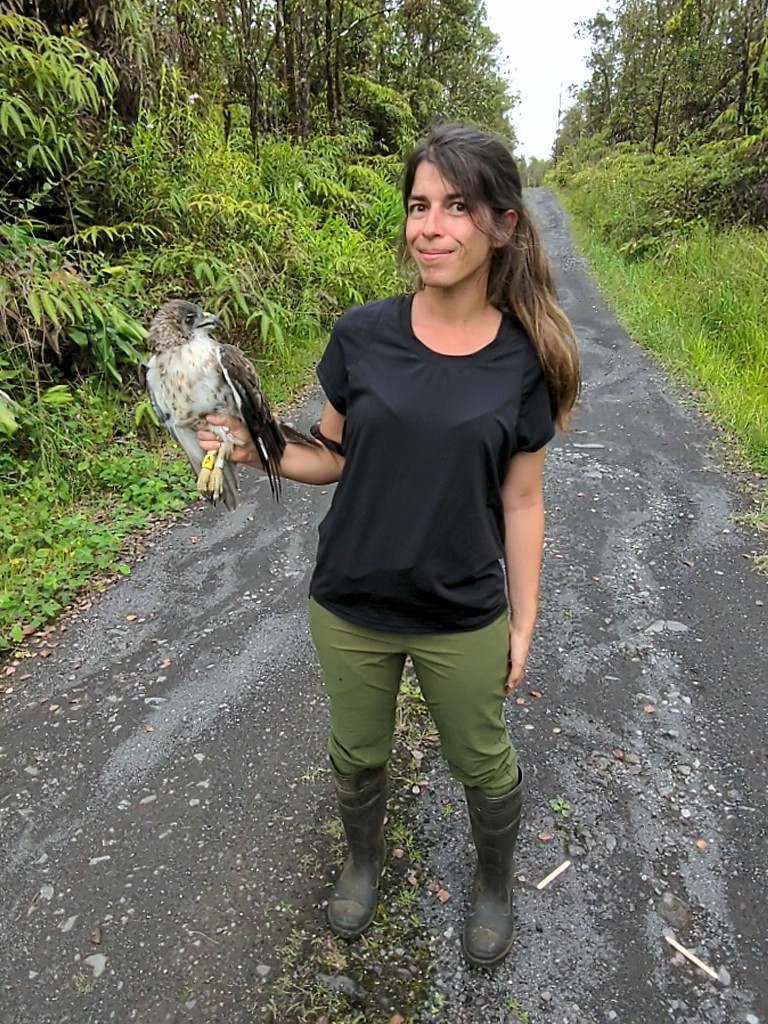 Amy was born in California, and now lives on Big Island. Her thesis is a GPS-Telemetry Study on Community Space Use Patterns and Intraspecific Home Range Variations of ‘Io – the Hawaiian Hawk (Buteo solitarius). Her research is conducted in Pu'u Maka'ala Natural Area Reserve and Surrounding Areas. A fun fact about her study species is that in addition to hunting from flight and perch, 'Io sometimes run along branches and jump from higher branches to lower ones (or onto the ground) while in pursuit of prey. Her research involves catching, banding, and fitting 'Io with GPS/Solar transmitters. Her favorite part of her thesis has been working in the field and getting to connect with 'Io. The most challenging part is working with people and formulating a research plan.
Amy was born in California, and now lives on Big Island. Her thesis is a GPS-Telemetry Study on Community Space Use Patterns and Intraspecific Home Range Variations of ‘Io – the Hawaiian Hawk (Buteo solitarius). Her research is conducted in Pu'u Maka'ala Natural Area Reserve and Surrounding Areas. A fun fact about her study species is that in addition to hunting from flight and perch, 'Io sometimes run along branches and jump from higher branches to lower ones (or onto the ground) while in pursuit of prey. Her research involves catching, banding, and fitting 'Io with GPS/Solar transmitters. Her favorite part of her thesis has been working in the field and getting to connect with 'Io. The most challenging part is working with people and formulating a research plan.
Matthew Dye
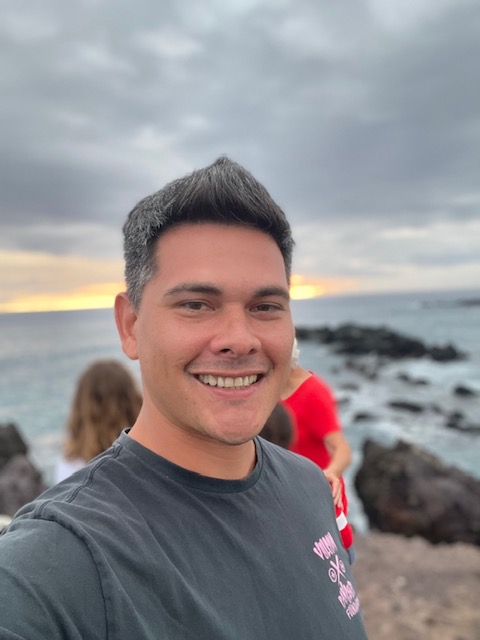 Matt is from Hilo, Hawai‘i. His thesis is on upgrading black soldier fly larvae meal for aquatic feeds using a sustainable microbial process. His research is at the ahupua'a of Panaewa on the moku of Hawai‘i. When asked for a fun fact, he said, “soldier fly larvae can be cultivated using organic waste that would otherwise be turned to pollution”. He volunteers at a non-profit called ka Ike o ka aina during the summers where we use indigenous Hawaiian knowledge to perpetuate and teach young students about science through a cultural lens. The non-profit is located in the ahupua'a of Puanui on the leeward Kohala coast. It is the thinnest ahupua'a on the island, but stories are told that it was one of the most productive ahupuaa on the island. His favorite part of the thesis experience has been learning the scientific process and how to test a proposed hypothesis. Expects that the most challenging part will be writing the manuscript.
Matt is from Hilo, Hawai‘i. His thesis is on upgrading black soldier fly larvae meal for aquatic feeds using a sustainable microbial process. His research is at the ahupua'a of Panaewa on the moku of Hawai‘i. When asked for a fun fact, he said, “soldier fly larvae can be cultivated using organic waste that would otherwise be turned to pollution”. He volunteers at a non-profit called ka Ike o ka aina during the summers where we use indigenous Hawaiian knowledge to perpetuate and teach young students about science through a cultural lens. The non-profit is located in the ahupua'a of Puanui on the leeward Kohala coast. It is the thinnest ahupua'a on the island, but stories are told that it was one of the most productive ahupuaa on the island. His favorite part of the thesis experience has been learning the scientific process and how to test a proposed hypothesis. Expects that the most challenging part will be writing the manuscript.
Noah Hunt
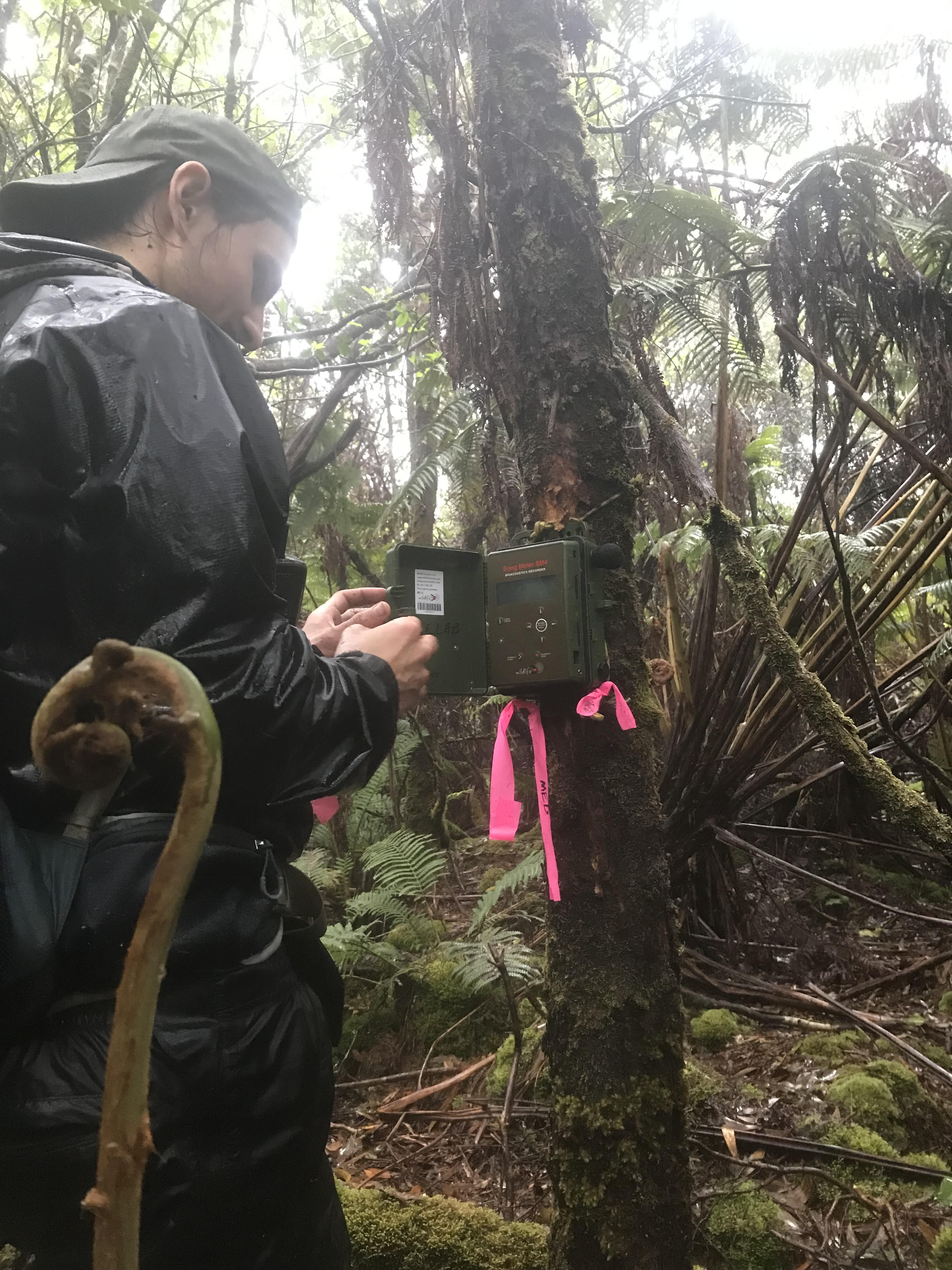 Noah is originally from Spokane, Washington. His thesis is on possible acoustic overlap between native and introduced Hawaiian birds. He is conducting his research in the Ahupua'a of Hakalau, Pauka'a. Hakalau Forest has the highest native forest bird diversity in Hawai'i Nui, and is one of the best places to study birds. Noah is investigating whether native and introduced forest birds are partitioning sound space for communication or are actively overlapping in signal space. He is also mentoring a PIPES intern in a study of the relationships between sound pressure level and distance for each species of forest bird. His favorite part of his thesis experience is getting into the field to see birds and plants with his lab hui. The most challenging part has been the design of this observational study. He has been surprised to find community types that are an even mix of native and introduced birds.
Noah is originally from Spokane, Washington. His thesis is on possible acoustic overlap between native and introduced Hawaiian birds. He is conducting his research in the Ahupua'a of Hakalau, Pauka'a. Hakalau Forest has the highest native forest bird diversity in Hawai'i Nui, and is one of the best places to study birds. Noah is investigating whether native and introduced forest birds are partitioning sound space for communication or are actively overlapping in signal space. He is also mentoring a PIPES intern in a study of the relationships between sound pressure level and distance for each species of forest bird. His favorite part of his thesis experience is getting into the field to see birds and plants with his lab hui. The most challenging part has been the design of this observational study. He has been surprised to find community types that are an even mix of native and introduced birds.
Dan Dio Mikros
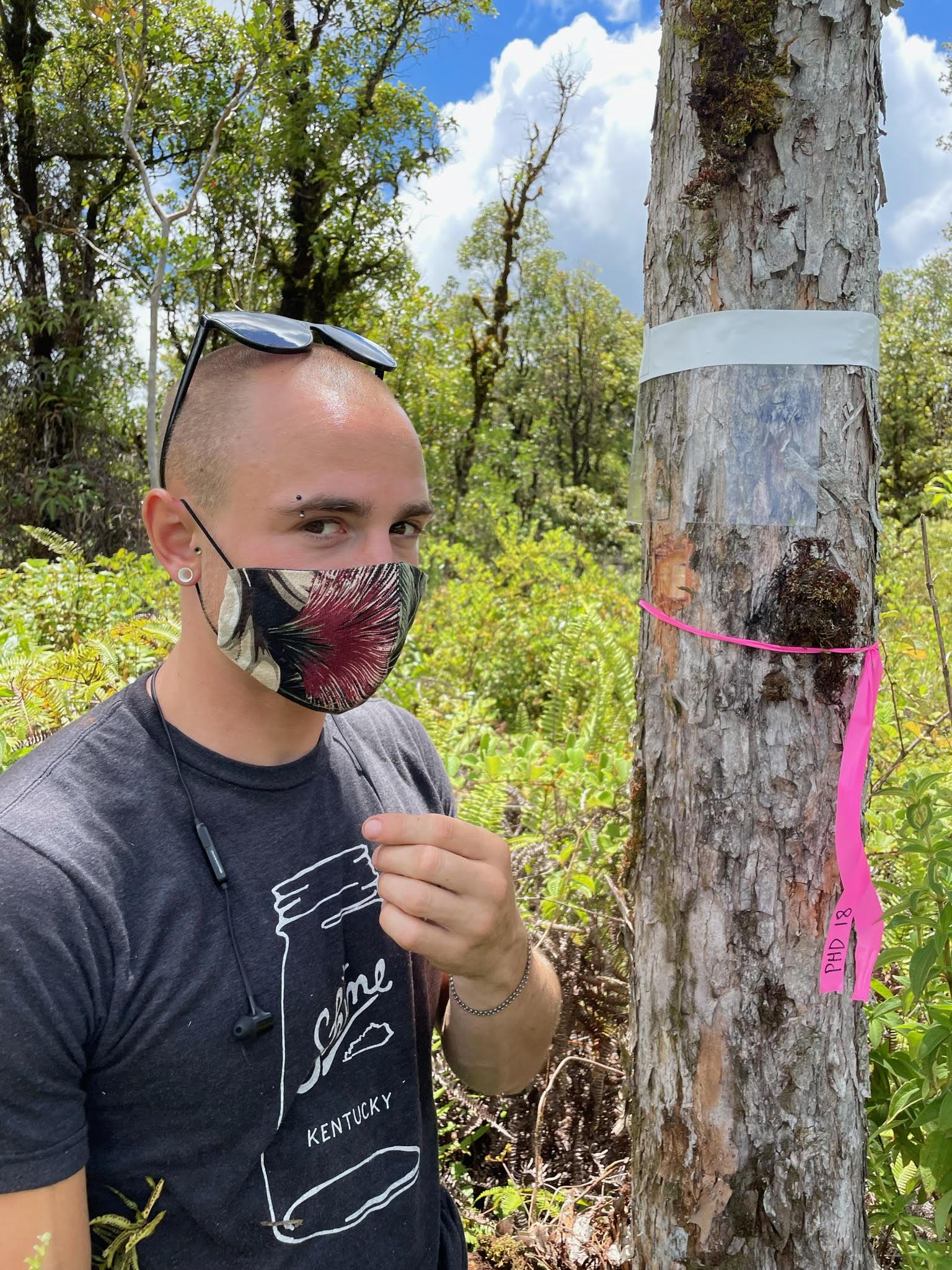 Dan is from Chicago. For his thesis, he is evaluating the efficacy of semiochemical repellent compounds in the management of rapid ʻōhiʻa death (ROD) associated ambrosia beetles in Waiākea Forest Reserve. Ambrosia beetles derive their name from the symbiotic relationship they have with so-called "ambrosia fungi". Female beetles bore into trees and propagate fungi within the tunnels to feed on. Each species uses special organs called mycangium to transport specific fungal symbionts which they then farm for sustenance. For the last four years, Dan has worked in the ROD entomology lab conducting an array of research projects which are on the forefront of the battle against the novel disease. Starting the TCBES program has provided him an opportunity to progressively develop this work while taking personal ownership of the research and solidifying his sense of contribution to the protection of the Hawaiian Island ecosystems. He has most enjoyed meeting and working with an eclectic group of peers who come from diverse backgrounds but share uniting passions for ecology and the environment. He was most concerned about learning biological statistics in R, but it turned out to be a greatly enriching challenge which had been a defining factor in making him feel like a properly competent scientist.
Dan is from Chicago. For his thesis, he is evaluating the efficacy of semiochemical repellent compounds in the management of rapid ʻōhiʻa death (ROD) associated ambrosia beetles in Waiākea Forest Reserve. Ambrosia beetles derive their name from the symbiotic relationship they have with so-called "ambrosia fungi". Female beetles bore into trees and propagate fungi within the tunnels to feed on. Each species uses special organs called mycangium to transport specific fungal symbionts which they then farm for sustenance. For the last four years, Dan has worked in the ROD entomology lab conducting an array of research projects which are on the forefront of the battle against the novel disease. Starting the TCBES program has provided him an opportunity to progressively develop this work while taking personal ownership of the research and solidifying his sense of contribution to the protection of the Hawaiian Island ecosystems. He has most enjoyed meeting and working with an eclectic group of peers who come from diverse backgrounds but share uniting passions for ecology and the environment. He was most concerned about learning biological statistics in R, but it turned out to be a greatly enriching challenge which had been a defining factor in making him feel like a properly competent scientist.
Emma Stierhoff
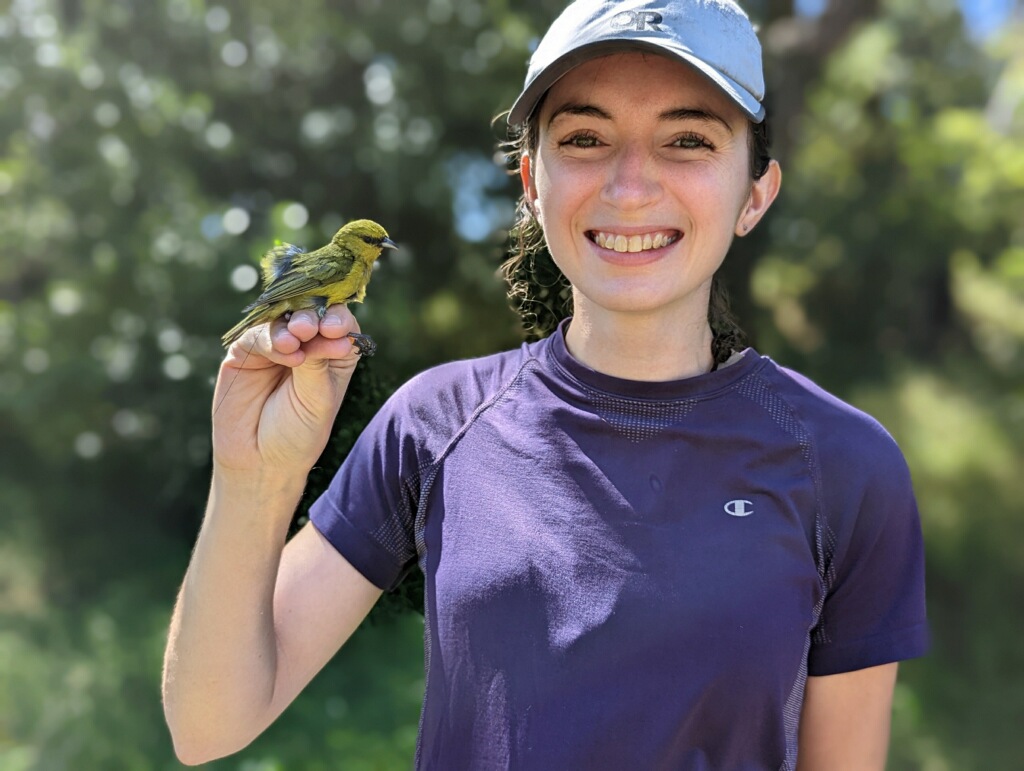
Zach Taylor
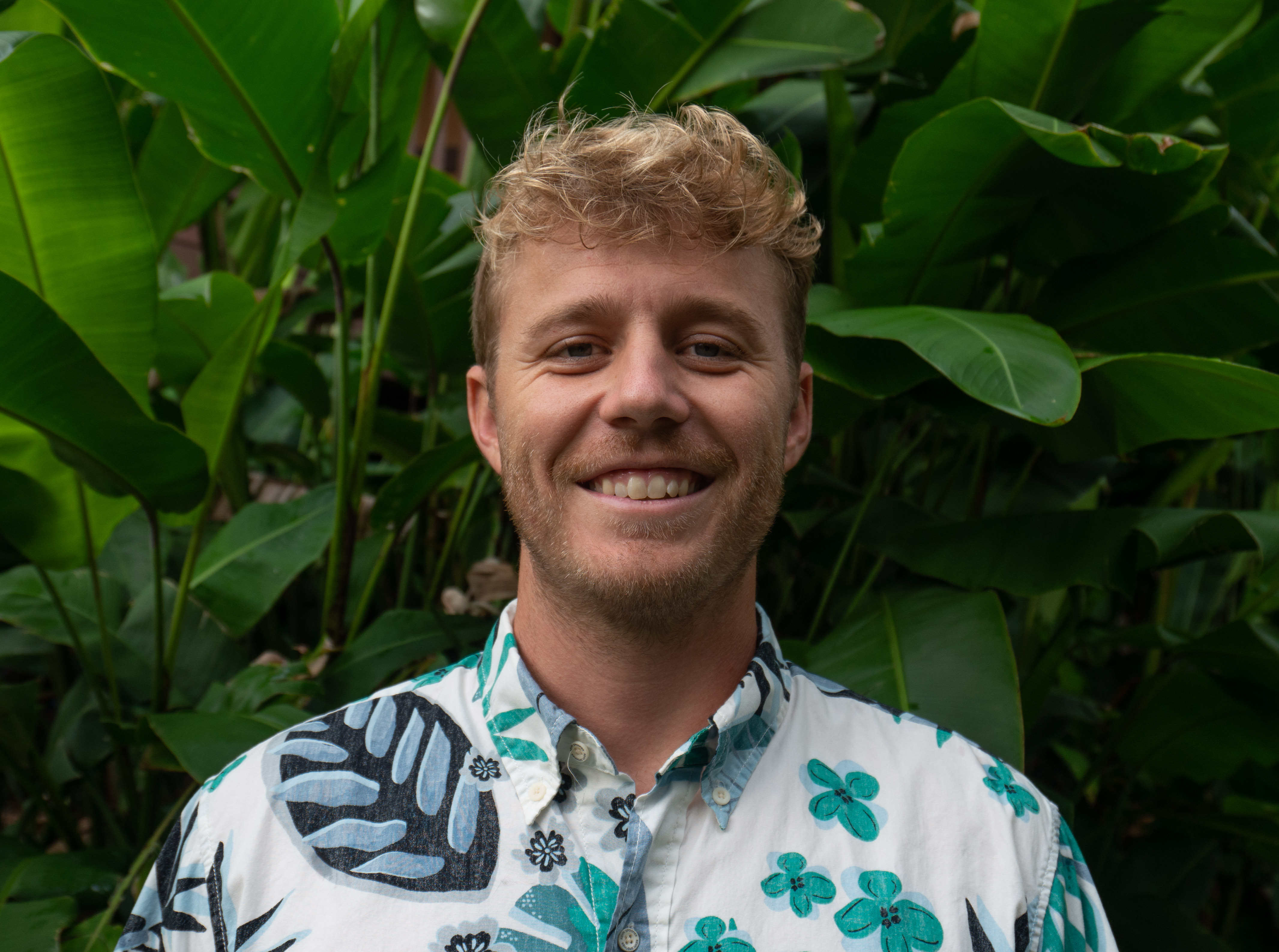 Zach is originally from Nebraska. His thesis is entitled, “Assessing the Accuracy and Quantitative Limitations of Traditional and Innovative Coral Reef Fish Surveys Methods”. He is conducting his research at Keahole Point. His research allows him the opportunity to see unique fish species on a routine basis that are only possible to see in Hawai'i, where roughly 21% of all reef fishes are endemic. As a part of the MEGA Lab, he is working to enhance and develop innovative survey methods to better conserve and protect coral reefs. He has really enjoyed being able to assist undergraduates with fish surveys, assist with digitizing and building 3D models of coral reefs, and work alongside many like-minded colleagues who push him to think creatively. His favorite part of the thesis experience has been working to conserve the marine resources that Hawai'i heavily relies on as a subsistence food source and economic pillar. The most challenging aspect of his thesis has been the planning and coordination of the field work to ensure it's done correctly and efficiently.
Zach is originally from Nebraska. His thesis is entitled, “Assessing the Accuracy and Quantitative Limitations of Traditional and Innovative Coral Reef Fish Surveys Methods”. He is conducting his research at Keahole Point. His research allows him the opportunity to see unique fish species on a routine basis that are only possible to see in Hawai'i, where roughly 21% of all reef fishes are endemic. As a part of the MEGA Lab, he is working to enhance and develop innovative survey methods to better conserve and protect coral reefs. He has really enjoyed being able to assist undergraduates with fish surveys, assist with digitizing and building 3D models of coral reefs, and work alongside many like-minded colleagues who push him to think creatively. His favorite part of the thesis experience has been working to conserve the marine resources that Hawai'i heavily relies on as a subsistence food source and economic pillar. The most challenging aspect of his thesis has been the planning and coordination of the field work to ensure it's done correctly and efficiently.
